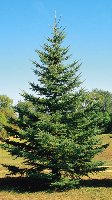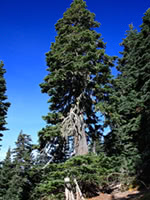Mon-Fri 9am - 5pm Mountain time
Black Hills Spruce vs Western Red Cedar
Picea glauca var. densata
Thuja plicata
NOT AVAILABLE THIS SEASON - MIGHT RETURN
Black Hills Spruce is a subspecies of White Spruce native to the Black Hills of South Dakota. It has a strongly conical form, slower growth rate and denser foliage than typical white spruce, making it preferable as a specimen tree for smaller suburban lawns. It also responds well to pruning, and can be used as a hedge or even bonsai.
Western Red Cedar is native to the Pacific Northwest, and is the largest tree in the cypress family. Featuring horizontal branching with scale-like dark green foliage that has a strong aroma. The wood is naturally durable and light, and is resistant to decay and insects, making it sought after for house siding, paneling, furniture, and fences. This is British Columbia's official tree.
Black Hills Spruce Quick Facts
Western Red Cedar Quick Facts
In row spacing: 3 - 4 m (10 - 12 ft)

